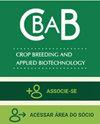Genotype x environment interaction in the iron and zinc biofortification of common bean grains
IF 1.1
4区 农林科学
Q2 Agricultural and Biological Sciences
引用次数: 11
Abstract
: Bean breeding programs have focused on the generation of early bush cultivars with higher yields, commercial acceptance and resistance to crop-limiting diseases. This study prioritized the nutritional quality in terms of iron (Fe) and zinc (Zn) content in bean grains grown in three high tropical environments. Two bush bean cultivars and five climbing bean cultivars were evaluated. The mineral content of the grains was determined with atomic ab - sorption spectroscopy. The results indicated that the bush genotypes Bacatá and Bianca are biofortified with Fe and Zn and the climbing cultivar Sutagao is biofortified with Zn. Statistical differences were found between genotypes (G), environments (E) and GxE interactions. According to the AMMI stability value (ASV), the cultivars Sutagao, Bianca and Iraca were stable, whereas Bacatá, which was the one with the highest nutritional quality, was moderately stable. The Simijaca environment showed an adequate edaphic contribution to bean production with nutritional quality.基因型x在普通豆粒铁锌生物强化中的环境互作
豆类育种计划的重点是培育产量高、商业接受度高、抗作物限制性疾病的早期灌木品种。本研究以三种热带高海拔环境下生长的豆粒的铁和锌含量为营养品质的优先级。对2个灌木豆品种和5个攀缘豆品种进行了评价。用原子吸收光谱法测定了颗粒中矿物的含量。结果表明,灌木型bacat和Bianca基因型对铁和锌进行了生物强化,攀缘品种苏塔高对锌进行了生物强化。基因型(G)、环境(E)和GxE相互作用之间存在统计学差异。根据AMMI稳定值(ASV),苏塔高、比安卡和伊拉卡为稳定品种,而营养品质最高的bacat为中等稳定品种。土壤环境对豆制品的营养品质有一定的贡献。
本文章由计算机程序翻译,如有差异,请以英文原文为准。
求助全文
约1分钟内获得全文
求助全文
来源期刊
CiteScore
2.40
自引率
13.30%
发文量
25
审稿时长
6-12 weeks
期刊介绍:
The CBAB – CROP BREEDING AND APPLIED BIOTECHNOLOGY (ISSN 1984-7033) – is the official quarterly journal of the Brazilian Society of Plant Breeding, abbreviated CROP BREED APPL BIOTECHNOL.
It publishes original scientific articles, which contribute to the scientific and technological development of plant breeding and agriculture. Articles should be to do with basic and applied research on improvement of perennial and annual plants, within the fields of genetics, conservation of germplasm, biotechnology, genomics, cytogenetics, experimental statistics, seeds, food quality, biotic and abiotic stress, and correlated areas. The article must be unpublished. Simultaneous submitting to another periodical is ruled out. Authors are held solely responsible for the opinions and ideas expressed, which do not necessarily reflect the view of the Editorial board. However, the Editorial board reserves the right to suggest or ask for any modifications required. The journal adopts the Ithenticate software for identification of plagiarism. Complete or partial reproduction of articles is permitted, provided the source is cited. All content of the journal, except where identified, is licensed under a Creative Commons attribution-type BY. All articles are published free of charge. This is an open access journal.

 求助内容:
求助内容: 应助结果提醒方式:
应助结果提醒方式:


